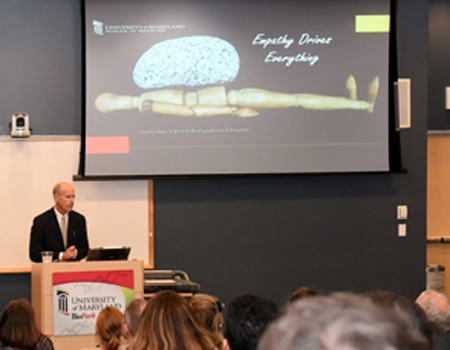Bartley P. Griffith, MD, took a riveted audience on the “Road to a Deep Breath” at the Entrepreneur of the Year presentation on Oct. 18, one of the highlights of UMB’s Founders Week celebration.
Griffith, the Thomas E. and Alice Marie Hales Distinguished Professor in Transplant Surgery at the School of Medicine, has spent 20 years developing the world’s first wearable, artificial lung system and founded Breethe, Inc. in 2014 to perfect and commercialize it.
“There is no worse death than one from loss of lung function,” Griffith says.
(View a photo gallery.)

Bartley P. Griffith, MD, delivered the Entrepreneur of the Year presentation, “Road to a Deep Breath,” on Oct. 18 at the University of Maryland BioPark.
To demonstrate his point, Griffith showed a PowerPoint slide of a huge rock sitting on a stick person’s chest to the audience at the BioPark Life Sciences Conference Center. It included the words “Empathy Drives Everything.”
Empathy is what has inspired Griffith in his Breethe quest. Hundreds of thousands of people die annually from lung failure. Griffith, as a surgeon who has done more than 1,250 heart transplants and 685 lung transplants, has seen firsthand the demoralizing life of those who are tied to a breathing machine in a hospital bed.
“If we build a better mousetrap, people can get up and live a more normal life, and we can get them out of the hospital,” Griffith told the audience of his original thoughts. The road wasn’t easy. There were setbacks as well as successes. “I love firsts,” says Griffith, who also was the first surgeon in America to implant a Jarvik heart in a patient and developed a pediatric heart pump.
It took decades but Griffith and his team have developed the first wearable artificial lung system. Fully portable, the pump lung unit, which is a little larger than a Coke can and sits on the patient’s belt, draws blood out down through the cannula. It oxygenates and removes carbon dioxide from the blood, which then goes back into the body. The unit also is attached to a portable pack on wheels, which contains batteries, the oxygen source, and the pump motor to control it.
“Our artificial lung device is different because of its inherently biocompatible and efficient design,” says Griffith, who also has built a resistance to clotting into it, saying “moving blood is good blood; stagnant blood is bad blood.”
With business partners Carl Cohen and Steve Orwig, who attended the presentation, and medical device executive Marshal Linder, who was out of the country, Griffith and the Breethe team are proceeding toward filing a 501(k) request for approval with the Food and Drug Administration in 2019.
Griffith, UMB’s 2010 Researcher of the Year, also credited funders like NIH and Robert Embry of the Abell Foundation, who was on hand, bioengineers like Jon Wu and Jiafeng Zhang, the UMB tech transfer office, and University leadership.
“I would be the poster boy for learning that multidisciplinary involvement is the key and the crutch that most surgical scientists have to fall upon,” said Griffith. He said the pump lung unit, which crams a surface area of 72 square meters, the size of a tennis court, into a Coke can-sized device, really is the work of the bioengineering community.
“We have passion, we have direction,” Griffth said, “but it’s that partnership between the empathetic physician that draws in the people who have the math skills to do the engineering that makes it click.”
He urged others to “innovate fearlessly” and humbly said he was just a surgeon. E. Albert Reece, MD, PhD, MBA, vice president for medical affairs at UMB and dean of the School of Medicine, disagreed in his introduction.
Said Reece: “If I had the skills to develop the perfect School of Medicine physician/scientist, that person would look highly likely like Bart Griffith. That person would be a gifted and dedicated clinician, a collaborative and determined researcher, and an innovative and visionary entrepreneur. That’s the full package, and Dr. Griffith, I believe you are the embodiment of that.”
After Griffith’s presentation, Phil Robilotto, assistant vice president in UMB’s Research and Development Tech Transfer Office, honored UMB faculty who received patents in the previous year. (See the list.)


